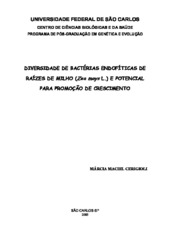| dc.contributor.author | Cerigioli, Márcia Maciel | |
| dc.date.accessioned | 2016-06-02T20:20:38Z | |
| dc.date.available | 2006-02-16 | |
| dc.date.available | 2016-06-02T20:20:38Z | |
| dc.date.issued | 2005-01-31 | |
| dc.identifier.citation | CERIGIOLI, Márcia Maciel. Diversidade de bactérias endofíticas de raízes de milho (Zea mays L.) e potencial para promoção de crescimento.. 2005. 149 f. Tese (Doutorado em Ciências Biológicas) - Universidade Federal de São Carlos, São Carlos, 2005. | por |
| dc.identifier.uri | https://repositorio.ufscar.br/handle/ufscar/5427 | |
| dc.description.abstract | Due to the ever-increasing amounts of nitrogenous and phosphates fertilizers which are used for crop production, the great energy need for the production of these, and to the environmental impact provoked by the lixiviate, it is becoming very important to try to extend biological nitrogen fixation to nonlegume, as well as the use of the solubilization of inorganic phosphate of reservations of the soil for the bacterias turning it available the plants in general. It is also important the understanding of the interaction bacteria-plant in the
production of the auxin IAA and your use in the increase of the crop production, besides the knowledge of the diversity of endophytic bacterias for a possible use of the same in several ways, due to your adaptation to the internal conditions of the plants. This way, this work had as objectives to study the diversity of bacterias endofíticas in the culture of the corn (Zea mays) and to select endophytic with potential for the growth promotion and your activity in the plant. This work had
as objectives study the diversity of endophytic bacterias in the culture of maize (Zea mays) and to select of their plant-growth promoting potential and activity in the plant. The diversity was evaluated in plants collected at four places of the State of São Paulo and the identification was performed by the fatty acids method extraction (FAME). A great number of bacterias was isolated where the difference can be observed in the diversity in relation to the places. The largest
diversity of species was observed at the place of Lins. The group Proteobacteria prevailed in the endophytic bacterial communities being the γ- subdivision and in the Enterobacteriaceae Famíly the most frequent and with
larger diversity. The most frequent genus were Stenotrophomonas and Bacillus. The populations endophytic maize present characteristics related to the plant growth promotion as, production of IAA, nitrogen fixation, and to solubilize phosphate. The different cultivation conditions and genotypes, as well as of developmental stage they might have influenced the observed physiologic diversity. Endophytic bacterias belonging to the species Klebsiella pneumoniae, Microbacterium saperdae, Stenotrophomonas maltophilia, Enterobacter cloacae, Bacillus megaterium and Pseudomonas mucidolens promoted the increase of root weight and of the aerial part of maize plants, presenting to
application potential. | eng |
| dc.format | application/pdf | por |
| dc.language | por | por |
| dc.publisher | Universidade Federal de São Carlos | por |
| dc.rights | Acesso Aberto | por |
| dc.subject | Microbiologia | por |
| dc.subject | Microbiologia endofítica | por |
| dc.subject | Milho | por |
| dc.subject | Bactérias | por |
| dc.subject | Ácido indol-acético | por |
| dc.subject | Nitrogênio - fixação | por |
| dc.title | Diversidade de bactérias endofíticas de raízes de milho (Zea mays L.) e potencial para promoção de crescimento. | por |
| dc.type | Tese | por |
| dc.contributor.advisor1 | Melo, Itamar Soares de | |
| dc.contributor.advisor1Lattes | http://genos.cnpq.br:12010/dwlattes/owa/prc_imp_cv_int?f_cod=K4783864Z5 | por |
| dc.description.resumo | Devido ao emprego sempre crescente da quantidade de fertilizantes nitrogenados e fosfatados necessários à produção agrícola, a alta exigência energética para a produção dos fertilizantes, e ao impacto ambiental provocado
pela lixiviação destes produtos, torna-se muito importante estender o processo de fixação biológica de nitrogênio a plantas não leguminosas, bem como a utilização de fosfato inorgânico de reservas do solo, disponível através da
solubilização pelas bactérias, para as plantas de forma geral. Além disso, é importante o entendimento da interação bactéria-planta na produção da auxina AIA, bem como o conhecimento da diversidade das bactérias endofíticas para
sua utilização no aumento da produção agrícola, pois vários fatores interagem nesta interação. Assim, este trabalho teve como objetivos estudar a diversidade de bactérias endofíticas na cultura do milho (Zea mays), selecionar linhagens com
potencial para a promoção de crescimento e testar a atividade na planta. A diversidade foi avaliada em plantas coletadas em quatro localidades do Estado de São Paulo e a identificação das bactérias foi realizada pelo método de
extração dos ácidos graxos (FAME). Foi isolado um grande número de bactérias e observou-se uma diferença na diversidade em relação às diferentes localidades. O grupo Proteobacteria prevaleceu nas comunidades bacterianas
endofíticas sendo a subdivisão gama (γ) e a Família Enterobacteriaceae as mais freqüentes e com maior diversidade. Os gêneros mais freqüentes foram
Stenotrophomonas e Bacillus. As populações endofíticas de milho isoladas das quatro localidades amostradas, apresentam características relacionadas à promoção de crescimento vegetal como, produção de AIA, capacidade de fixação de nitrogênio e de solubilização de fosfato. As diferentes condições de cultivo, os genótipos, bem como de estádios fenológicos podem ter influenciado a diversidade e diversidade fisiológica observada. As bactérias endofíticas pertencentes às espécies Klebsiella pneumoniae, Microbacterium saperdae,
Stenotrophomonas maltophilia, Enterobacter cloacae, Bacillus megaterium e Pseudomonas mucidolens promoveram o aumento de peso de raiz e da parte aérea de plantas de milho, apresentando potencial para utilização. | por |
| dc.publisher.country | BR | por |
| dc.publisher.initials | UFSCar | por |
| dc.publisher.program | Programa de Pós-Graduação em Genética Evolutiva e Biologia Molecular - PPGGEv | por |
| dc.subject.cnpq | CIENCIAS BIOLOGICAS::MICROBIOLOGIA | por |
